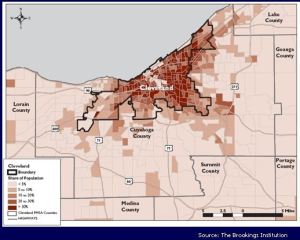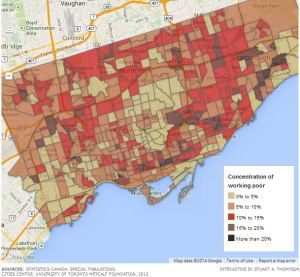Dave Hardy, R.P.P. — July 2016
In 1998, the cities of Etobicoke, York, East York, North York, Scarborough, and Toronto, making up Metropolitan Toronto, were amalgamated into the City of Toronto. In 2014, the Rotary Clubs in Scarborough (coalition of 5 different Rotary Clubs in Scarborough) saw that one of the former municipalities, Scarborough, had close to half of the poverty areas in Toronto and they were concerned.
In contrast to US cities, poverty areas in Toronto are in the suburbs and the wealthy live in the core. David Hulchanski, Professor at the University of Toronto identifies three cities in Toronto in his report (1), “The Three Cities Within Toronto: Income Polarization Among Toronto’s Neighbourhoods, 1970-2005”. He illustrated that in Toronto, in 1970, the low-income households were in the Downtown area near accessible transit. But by 2005, they had been pushed to the inner-suburbs where transit services are poor.
Today, City #1 is the high-income urban core where residents have seen incredible benefits from urban growth. For example, in Toronto’s tony Forest Hill community only a few houses sell for under $2 million – many are valued at over $4 million. House prices, home equity and family wealth continues to rise in this area.
City #2 is the middle-income area where residents are keeping up with the growth of the economy. This group is shrinking as a result of the growing gap between the high and low-income population.
City #3 is the low-income area that sits mostly outside of the subway lines. This includes inner-suburbs, such as Scarborough, where many people struggle to pay for housing, a basic need. Because of their poor access to quality public transit, many Scarborough residents, especially those at the low-income bracket are required to commute long distances of up to 20 kilometers on public transit to get to work in the core.
Rotarians saw community developers and social workers in City #3 doing a very good job at poverty alleviation, workforce training and implementing programs to help lift people out of poverty. The City of Toronto appropriately stepped up and assigned Neighbourhood Improvement Area status to these neighbourhoods and provided supportive programming.
But the Rotarians wanted to know, in one of North America’s wealthiest cities, what are the causes of poverty? Particularly, when Scarborough once was called the “City of the Future”, why does it have so much poverty today? So, they hired Hardy Stevenson and Associates Limited (HSAL) to conduct research on Scarborough, focusing on five areas: urban planning, arts and culture, health care, economic development and social development. Effectively, they asked HSAL to peel back the onion.
In parallel, the Rotarians initiated a two-year-long Scarborough-wide economic and community development campaign. They paid HSAL to complete research on community renewal and talked to thousands of people through an extensive public consultation campaign – town halls, individual interviews and open houses.
This article summarizes some of the findings and recommendations and presents a distinct suburban view about what people in City #3 are seeing.
Let me begin with the context:
The former City of Scarborough has a large population. At about 625,000 residents in 2011 (2), it represents one quarter of the population of the City of Toronto and just under one third of the land mass. It has a larger population than Halifax, which is the largest city in eastern Canada. Indeed, it has a larger population than two Canadian provinces – Newfoundland and Labrador and Prince Edward Island.
Scarborough residents have a strong vision of who they are. And, they are proud of where they live.
Scarborough is one of the most racially and ethnically diverse places on the face of the planet. HSAL calls it a “world within a city”.
Residents are polite, intelligent and they like each other. In spite of several higher profile crime incidents several years ago, it is one of the safest places in Toronto to live.
The sense of community and solidarity shared by Scarborough residents is reinforced by them constantly hearing condescending comments from other parts of the city. Over the course of our study, we even heard Canada’s National publically funded broadcaster, the CBC, joining the condescension by calling Scarborough a wasteland (3). Scarborough residents have become fed up with how they are viewed.
So, how are residents of City #3 experiencing the City of Toronto?
Let’s start with the economy.
When Scarborough residents look at the City of Toronto’s wealthy core they see a successful city with jobs centred on: finance, information technology, processed food, education and knowledge creation and life sciences. Toronto’s economy is doing famously well. Scarborough residents are pleased that the core is doing well and want nothing that detracts from that.
In contrast, when Scarborough residents think about their economy, they remember that they once had the strongest manufacturing sectors in Canada. Post-amalgamation and with free trade, Scarborough has shifted from a strong manufacturing economy to a retail economy.
It is hard to overlook the stark difference between the performance of City #1’s economy and that of City #3. Over a recent 4 year period (4) Toronto gained 1.6 million square meters of new office space while Scarborough only managed to attract 6,000 square meters of office space. From 2002 to 2012 Toronto gained 68,000 new well-paying jobs. In the same time period, Scarborough lost 1,700 jobs. At this time, Scarborough’s manufacturing sector lost over 14,000 jobs. For the poor in Neighbourhood Improvement Areas, once people are trained the jobs they need aren’t there. It is, in part, the responsibility of the City to support economic development planning so that residents have jobs; but there’s no Scarborough specific economic development plan.
What about healthy communities?
Healthy communities are viewed by core area city planners as places where people are have good diets, ride their bikes to work and do recreational walking. To Scarborough residents, having a healthy community means equitable access to basic medical services.
There are three hospitals in Scarborough and all of them are in dire need of significant funding from the Province of Ontario – the level of government in Canada that is responsible for the majority of health care funding.
One of them is The Scarborough Hospital’s (TSH) Birchmount Campus (also known as Scarborough Grace). It has an emergency room designed to accommodate 20,000 visits per year but in 2014/15 they had 50,000 visits (5). Also, this hospital ranks in the bottom 10% of all hospitals in the Province of Ontario.
The Rouge Valley Hospital System is another hospital in Scarborough and is in dire need of investment. Similar to the TSH Birchmount Campus, the emergency department gets more visits than it was designed for – designed for 25,000 and had 65,000 visits in 2014/15 (6). Those are Scarborough’s good hospitals.
The TSH Scarborough General Campus’ operating rooms are about the oldest in Ontario (7). In a post-SARS world, the General Campus does not have the capability of keeping the clean areas separate from the dirty areas.
In April 2016, the Province announced a new investment of over $10 million in Scarborough hospitals as part of the 2016 Budget, which includes: 1) $4.5 million in increased operating funds for Rouge Valley Health System, and 2) $2.9 million in new operating funding for The Scarborough Hospital. Work is underway to provide capital funding for new hospitals although the funds may not materialize for 12 to 15 years. While Scarborough residents are happy to hear their hospitals are receiving funding, the announcement is a day late and a dollar short. By the time The Scarborough Hospital receive capital funds, the operating room will be over 75 years old.
How about arts and culture facilities?
What do Scarborough residents see when we look at core city
investment in arts and culture?
The core area of the City of Toronto is one of the best entertainment and cultural hot spots in North America. Scarborough residents are generally happy to see this success. But they see this success through a lens –
And here it is in the form of two jeopardy questions:
The category is performers.
Here’s the answer:
- The Weeknd, Mike Myers, Lawrence Gowan, Monika Schnarre, Barenaked Ladies, Marilyn Denis, Jim Carrey, Doris McCarthy, Ben Heppner, Peter Appleyard, Gerry Dee, Carole Pope, and the list is long.
The question is: Who has Scarborough roots?
The next category is ‘support for the arts’.
Here’s the answer:
- Galleries, museums, concert halls, exhibit spaces, performance spaces.
The question is: What cultural facilities does Scarborough lack?
Arts and cultural capital investment, part of the pre-amalgamation planning has never materialized.
What about transit?
Poor transit in Scarborough is evident when residents have to wait a long time for a bus that could connect them to another bus, Scarborough Rapid Transit (light rapid transit line), or the subway. It is also evident when those who rely on food banks have to commute for 40 minutes to get to a food bank in Scarborough.
And more interestingly, residents in City #1 who have reliable and accessible transit say they don’t go to Scarborough because it is not easy to get there by transit. This clearly minimizes opportunities for growth in Scarborough’s economy and support for arts and cultural activities (8).
Transit policy and planning is normally built upon Official Plans and Economic Development Plans. Good transit supports economic development, residential investment and job creation. The current Scarborough transit debate is being framed by City # 1 residents as building a subway to nowhere. Data is cherry-picked by Toronto’s core area chattering elites to show why transit isn’t needed in Scarborough. The necessary Official Plan and Economic Development supports are missing.
Complete City Needed
It is advantageous for city building to envision a ‘complete city’ rather than a city where some parts do very well and other parts suffer. If having Scarborough residents and other suburban residents equally participating in City life is important, let me share my ideas on how to build a complete city.
How does Toronto become as a complete city?
In Toronto, the suburbs are the key:
1. Completing the city means rethinking how we do city planning.
City planners are doing an excellent job in City #1. The core is booming. Planners have a steady stream of development and growth opportunities to manage. The focus of core area urban planning is great design and managing neighbourhood sensitivities.
But, the type of city planning that does so well for the core is not the same planning that is needed for the suburbs. It’s the difference between planning how to manage growth vs how to attract growth to the suburbs.
Suburban residents need, and are not getting, planning that delivers a positive context for community enhancement, place making and economic development. In part, suburban residents need the type of excellent planning that occurs in Peel Region, Vaughan, Markham and the rest of the 905 (905 is the telephone area code for Toronto’s outer suburbs).
In relation to the suburbs, Toronto’s Official Plan has not performed well and needs a lot of work. City-building through the Official Plan needs to link social, economic and environmental development. This involves suburban specific studies and actions to be implemented that arise from the studies.
The suburbs need a district vision, strategic plan, an integrated sustainability plan, transit plan, economic development plan and arts and culture plan. And, all of these plans need to be rolled into land-use policies. These studies and policies have not been developed.
2. Completing the city means looking carefully at how the city budget is being allocated.
What do Scarborough residents see in terms of where their tax dollars are being spent?
HSAL looked at a budget breakdown produced by company called Lonely Datum who created an interactive map using the City’s dataset on the City’s capital expenditures by ward between 2014 and 2023 (9).
What the data shows is several of Toronto’s wealthy wards get 10x more capital investment than all of Scarborough. Of the 13 lowest expenditure wards, 8 Scarborough wards are at the bottom of the City’s capital spending priorities over this period.
The core area wealthy in one Ward alone, Ward 20, who comprise almost 3 percent of Toronto’s population, are recipients of $58 million in City capital expenditures. Whereas Scarborough’s combined Wards 35, 36, 37, 38, 39, 40, 41, 42, 43, 44 representing 24 percent of the City’s population is the recipient of $50 million. These numbers speak to the lack of City investment in Scarborough despite the needs of the population.
Investment is needed in the hospitals, agencies such as the Agincourt food bank, transit, arts and culture, transit and employment growth areas.
3. ‘New Suburbanism’ as an Integrating Idea.
Let me end by sharing an integrating idea; an idea that can help ‘mend’ the City.
A very good integrating idea for complete city building is called ‘new suburbanism’. It essentially involves planning for and building a complete region.
“New suburbanism” asks us to change our thinking on how we see the relationship between the city, suburbs and rural areas. Rather than being seen as dormant areas, suburbs need to be envisioned as vital, active areas contributing to the growth of the core, rural areas and the Region. The ‘Region’ in this instance is the eastern part of the Greater Toronto Area.
It acknowledges that a strong city needs both strong suburbs and strong rural areas. It reasserts the role of suburbs as broker between urban and rural areas. Essentially, you can’t have a strong core without strong suburbs. Similarly, you can’t have strong rural areas without strong suburbs.
Adopting “new suburbanism” City planning principles means changing our thinking. It asks us to move away from a planning philosophy that has as the priority, the strength of the core; where planners assume that if the City core is strong there will be some sort of trickle-down benefits to the suburbs.
Instead, it asks us to see that:
Suburbs are not sub-urban; or lesser places than core urban places. They are simply different than urban. They are not places that people live in because they can`t afford to live in the better core areas. Instead, people live in the suburbs because they want to live in the suburbs. The suburbs provide green spaces, convenient shopping and spacious homes. The suburbs offer housing at a more affordable price than in the core. They were well planned as cohesive suburban neighbourhoods and continue to perform that role.
The core area of Toronto is undergoing considerable growth pressure, not dissimilar to London and New York. To address these outward growth pressures, growth following new suburban planning principles would mean that planners would combine greater suburban density with great suburban design. Future suburban areas will see high qualities of life, entertainment and arts facilities and neighbourhood preservation occurring in concert with growth. It involves community groups and developers working together to direct growth to best outcomes and to achieve community enhancements.
What’s required is a move from city-centred urban planning that overlooks suburban needs to region / district centred planning. Under new suburbanism, city planning begins with the city, suburbs and rural areas functioning as one.
Conclusion
Scarborough is a city that was amalgamated but never assimilated into the City of Toronto. It has the potential to be as vibrant as City #1 but it needs attention. It is lacking jobs, infrastructure dollars and new thinking of how suburbs should be planned and developed. Since the last municipal election Toronto has had an awakening of its suburban areas. I’m hoping it’s an awakening that has the ultimate result of the City coming together.
I submit that as the fourth largest city in North America, having the entire City working together towards achieving a complete city is much better for residents in every part of the City.
References
- http://www.urbancentre.utoronto.ca/pdfs/curp/tnrn/Three-Cities-Within-Toronto-2010-Final.pdf
- https://www1.toronto.ca/City%20Of%20Toronto/City%20Planning/Wards/Files/pdf/C/CCA_ESC%20Census%20Profile%202011.pdf
- http://openpolicyontario.com/scarborough-and-the-politics-of-resentment/
- City of Toronto. 2013. Profile Toronto.
- Report of the Scarborough/West Durham Panel (October 30, 2015) – Page 25
- Report of the Scarborough/West Durham Panel (October 30, 2015) – Page 26
- Report of the Scarborough/West Durham Panel (October 30, 2015) – Page 26
- https://hardystevensoninsights.com/2014/01/30/torontos-elites-and-scarboroughs-transit-victims/
- http://capital-budget.lonelydatum.com/ Note: HSAL has not been able to independently verify the data.

![Map 1: Change in average individual income, City of Toronto, Relative to the Toronto CMA, 1970-2005.[10]](https://hardystevenson.files.wordpress.com/2014/11/untitled-11.jpg?w=300&h=203)
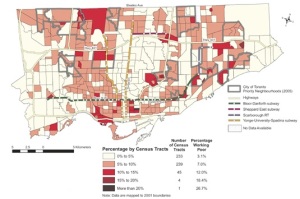
![City 3: Income decreased 20% or more since 1970.[6]](https://hardystevenson.files.wordpress.com/2014/11/untitled-3.png?w=300&h=200)
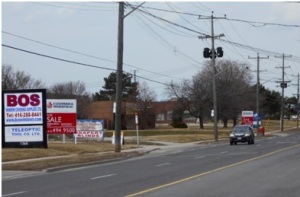

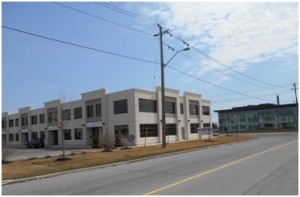
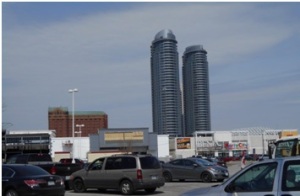
![Map 1: Toronto Zoning By-law Employment Industrial Zones, 2013.[14]](https://hardystevenson.files.wordpress.com/2014/11/untitled-5.jpg?w=300&h=232)








